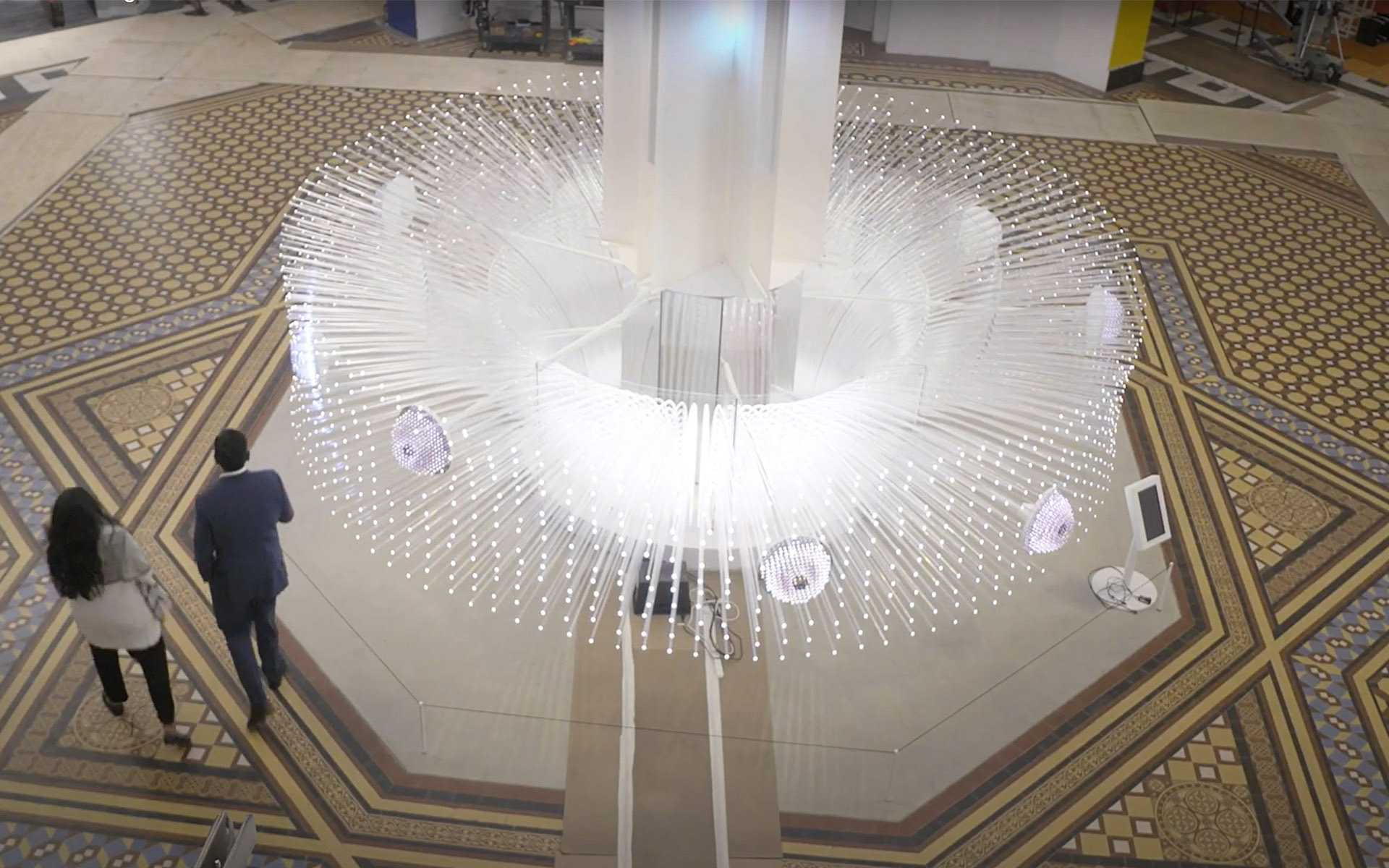Every day, women make history.
Women use technology both creatively and functionally to effect change. For Women’s History Month, we're showcasing Amazon Web Services (AWS) customers—from nonprofit to corporate—using tech to create institutional-level transformations that benefit girls and women.
Technology elevates art: AI art exhibit by a women-led team
An all-women team created a luminous, interactive sculpture commissioned by AWS and powered by AWS artificial intelligence (AI). The exhibit is at the Arts and Industries Building on the National Mall in Washington, D.C.
Titled me + you, the piece resulted from the collaborative vision of India-born architect and artist Suchi Reddy, arts curator Isolde Brielmaier, and AWS.
The installation is—literally—brilliant. The sculpture consists of thin, flexible sheets of LEDs, diffusers, acrylic tubes, and paper.
When visitors contribute their vision of the future by standing near the sculpture and saying the words "My future looks…,” and filling in the rest, AI technology translates their answers into patterns of light and color.
“It’s been this fantastic series of connections with amazing women who led us from the big idea to do an exhibition about the future to the very specific manifestation of me + you in our rotunda,” said Rachel Goslins, director of the Smithsonian Arts and Industries Building.
“Technology allows museums to open up and become more accessible,” said Brielmaier. She added that it causes them to "really think very, very critically about issues of diversity and equity.”
Reddy and Brielmaier’s work on the sculpture represents art innovation by women in the 21st century, as they take the discipline into new territory.
Nonprofit impacts careers: Girls Who Code
The median wage in tech is double that of the national median wage, with an estimated half-million new tech jobs emerging by 2029. Girls Who Code is one of the largest girls’ international nonprofit organizations in the world. The organization endeavors to close the gender gap in entry-level tech jobs by 2030.
Girls Who Code is doing its part to prepare girls for the jobs of the future through programs like Girls Who Code clubs. The clubs are communities for students in grades 3–12, where they learn coding skills and examine portraits of women who work in tech, as role models. The nonprofit organization also has a virtual, two-week Girls Who Code Work Prep program for young women. The program includes mentorship from women working in tech.
 Photo by @GirlsWhoCode
Photo by @GirlsWhoCodeThe organization’s initiatives serve dual purposes by impacting wage and opportunity gaps for girls of color. Girls Who Code works with corporate partners to address equity issues, including credentialing and promotion practices. It also advocates that firms consider girls and women from non-traditional backgrounds who can bring value and unique perspectives and strengths to the tech industry. Girls Who Code is an AWS customer and uses AWS technology solutions.
Companies create change: 8PERCENT and ADP
8PERCENT
The Korean financial services firm 8PERCENT is a fintech pioneer. When it launched in 2014, it created an industry segment that didn’t yet exist in Korea.
The Korean financial services firm 8PERCENT is a fintech pioneer. When it launched in 2014, it created an industry segment that didn’t yet exist in Korea.
Hyojin Lee, the company’s founder and chief executive officer, also overturned conventions by making 8PERCENT a mid-interest rate, loan-based business. Her company entered an environment where high-interest rates were the norm.
The woman-founded startup has raised over $24 billion (28 trillion KRW) in loan application funds. Building its products and services on AWS, the company aims to change the future for borrowers and investors, and help grow the wealth of ordinary Koreans investing via the 8PERCENT app
ADP
Automatic Data Processing, Inc. (ADP) is best known for its payroll, benefits, and human resources services, though it has also been doing work in diversity, equity, and inclusion (DEI) through its DEI Dashboard. Built on AWS, ADP helps companies run analytics to examine their workforces using segment variables including gender, ethnicity, veteran status, and age.
Automatic Data Processing, Inc. (ADP) is best known for its payroll, benefits, and human resources services, though it has also been doing work in diversity, equity, and inclusion (DEI) through its DEI Dashboard. Built on AWS, ADP helps companies run analytics to examine their workforces using segment variables including gender, ethnicity, veteran status, and age.
ADP also created Pay Equity Storyboard on AWS. The Pay Equity Storyboard provides insights, tools, and visualizations that a company can use to identify pay equity gaps between the company’s workforce and similar employers. The storyboard also provides proactive solutions to correct gaps. ADP launched the storyboard in the summer of 2021. By December 2021, over 210,000 people saw their pay increase, on average, by $3,500.
According to ADP analytics that tracked employment statistics from the start of the pandemic in March 2020, job losses exacerbated the existing pay gap between men and women. "Men actually fared a lot better than women during the pandemic,” said Jack Berkowitz, chief data officer at ADP. According to ADP, women lost 20 years of progress in terms of pay-equity gaps during the pandemic.
The storyboard helps companies identify the pay-equity gaps at their firms—including gender-based gaps—and delivers insights that empower companies to proactively address disparities.
“Now is the time to use data to help people understand what actions we can take to create a more diverse, equitable, and inclusive work environment and build the future we all want,” said Berkowitz.
Find more examples of AWS’s commitment to DEI throughout the year on the All Builders Welcome and Diversity, Equity, and Inclusion Customer Stories pages.











